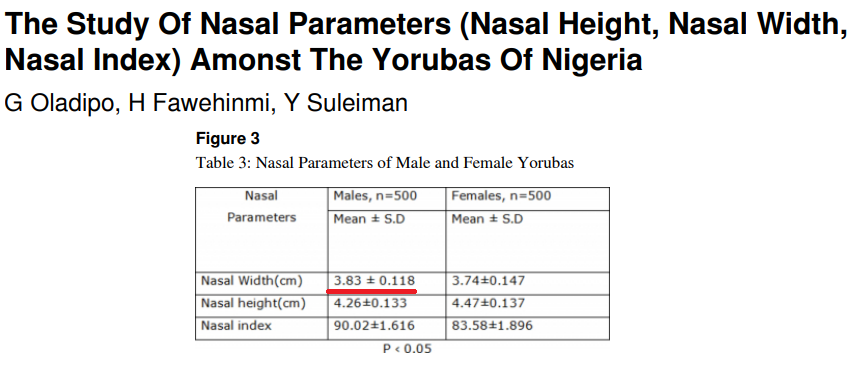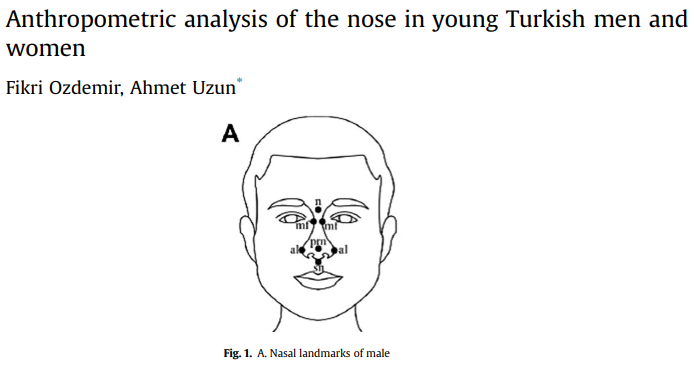Summary
A smaller nose width is considered more attractive in males. A study by Doug Jones (2011) from the University of Michigan found that a youthful male face is enhanced by features like a small nose, which can reduce perceived age and increase attractiveness. Similarly, research by Cunningham et al. (1990) linked masculinity to features such as an angular face and a smaller nose width, noting that men with narrower noses were often judged as more masculine and attractive. In a different context, Oladipo et al. (2008) examined nasal parameters among 1,000 Yoruba participants, finding an average male nose width of 3.83 cm (38.3 mm). Another study, Anthropometric Analysis of Nasal Features in Turkish Adults, measured nasal dimensions in 115 Turkish adults and found that males had an average nose width of 35.24 mm. Together, these studies suggest that a smaller nose width may be a key factor in perceived youthfulness, masculinity, and attractiveness in males.
Research
A study by Doug Jones (2011), Department of Anthropology, University of Michigan reports that a youthful face is one that combines a high ratio of lower-facial features with a small nose and ears and full lips . Additionally, a face with unusually large eyes, a small nose, and full lips compared to the face height can lower the predicted age of a man. These studies shed light on how “a small nose” is better than the wider one for overall attractiveness.
According to the Cunningham et al. (1990), perceived masculinity is related to certain facial features, including an angular face, thicker eyebrows, visible beard stubble, and larger smiles. However, masculinity is also connected with a smaller nose width. This suggests that participants in the study judged a face as more masculine when the nose was slightly narrower rather than wider. The smaller nose width could also be linked to perceived attractiveness, which is mentioned later in the text. So, in simple terms, men with smaller nose widths are often seen as more masculine and attractive compared to those with wider noses.
A study carried out by Oladipo et al. (2008) titled “The Study of Nasal Parameters (Nasal Height, Nasal Width, Nasal Index) Amongst the Yorubas of Nigeria” examined nose width in 1,000 Yoruba participants (500 males and 500 females) aged 18–45. Using sliding calipers, the study found that males had a mean nose width of 3.83 cm (or 38.3 mm).

Another study titled “Anthropometric Analysis of Nasal Features in Turkish Adults” analyzed nasal dimensions among young Turkish men and women. The study included 115 healthy adults (56 men and 59 women) aged 18–30, focusing on differences in nasal measurements. The findings revealed that males had a mean nose width of 35.24 mm.

Reference
Doug Jones, C. L. (2011, 9 12). Sexual Selection, Physical Attractiveness, and Facial Neoteny. p. 27. https://digitalcommons.usu.edu/cgi/viewcontent.cgi?article=1601&context=fchd_facpub
Cunningham, M. R., Barbee, A. P., & Pike, C. L. (1990). What do women want? Facialmetric assessment of multiple motives in the perception of male facial physical attractiveness. Journal of personality and social psychology, 59(1), 61. https://psycnet.apa.org/record/1991-01192-001
Oladipo, G., Fawehinmi, H., & Suleiman, Y. (2008). The study of nasal parameters (nasal height, nasal width, nasal index) amongst the Yorubas of Nigeria. Internet J Biol Anthropol, 3(2), 457-62. https://d1wqtxts1xzle7.cloudfront.net/84248129/7314-libre.pdf?1650098171=&response-content-disposition=inline%3B+filename%3DThe_Study_Of_Nasal_Parameters_Nasal_Heig.pdf&Expires=1730449949&Signature=KqCknFwSNkltJjKYr9YfhtSSUrA1ftmJtGWKZ18Rr8IisMevgexlZd-kjLMrHGe-OQkZMBphOlVRVfxYS5cK110buanh0C9dAV1LZ2sUyzQkYeg5y~OTNSJcbpMubM9owLLVGfj~yxbkJIg42gyD2Ib8eZv7siF5dcqwn6ZS4OneeyAJVy22CqBOl-1aWIrudBcTiBlTgjntJgcLHqdeK1BFSQMDweXrasJwoNax75ZRnegjMeiB2hxjq76ziNYv-HKvIhDEP~fhDNi7U9DTrEn2ier9DU-ntv8SW53eQNwDxSWgzQfdKUAzHaVrNml6IY8-dUuIidWmdSZLQHuqDw__&Key-Pair-Id=APKAJLOHF5GGSLRBV4ZA
Ozdemir, F., & Uzun, A. (2015). Anthropometric analysis of the nose in young Turkish men and women. Journal of Cranio-Maxillofacial Surgery, 43(7), 1244-1247. https://doi.org/10.1016/j.jcms.2015.05.010
